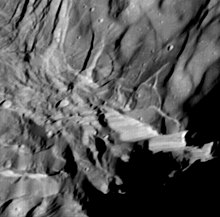18°18′S 347°48′E / 18.3°S 347.8°E [1]

Verona Rupes is a cliff on Miranda, a moon of Uranus. [3] It was discovered by the Voyager 2 space probe in January 1986. The cliff face, previously thought to be from 5 to 10 km (3 to 6 mi) [4] high, is currently estimated to be 20 km (12 mi) [5] high as of 2016, which makes it the tallest known cliff in the Solar System. [6]
It may have been created by a major impact, which caused the moon to disrupt and reassemble, [3] [6] or by the crust rifting. [7]
Given Miranda's low gravity, it would take about 12 minutes to fall from the top, reaching the bottom at the speed of about 200 km/h. [5]
References
- ^ "Verona Rupes". Gazetteer of Planetary Nomenclature. USGS Astrogeology Research Program.
- ^ "PIA00044: Miranda high resolution of large fault". JPL, NASA. Retrieved 2007-07-23.
- ^ a b "Miranda". USGS. 2003-05-08. Retrieved 2006-11-28.
- ^ Thomas, P.C. (1988). "Radii, shapes, and topography of the satellites of Uranus from limb coordinates". Icarus. 73 (3): 427–441. Bibcode: 1988Icar...73..427T. doi: 10.1016/0019-1035(88)90054-1.
- ^ a b "APOD: 2016 November 27 - Verona Rupes: Tallest Known Cliff in the Solar System". apod.nasa.gov. Retrieved 2018-02-20.
- ^ a b Chaikin, Andrew (2001-10-16). "Birth of Uranus' provocative moon still puzzles scientists". space.com. Imaginova Corp. p. 1. Archived from the original on July 9, 2008. Retrieved 2007-07-23.
- ^ Chaikin, Andrew (2001-10-16). "Birth of Uranus' provocative moon still puzzles scientists". space.com. Imaginova Corp. p. 2. Retrieved 2007-07-23.